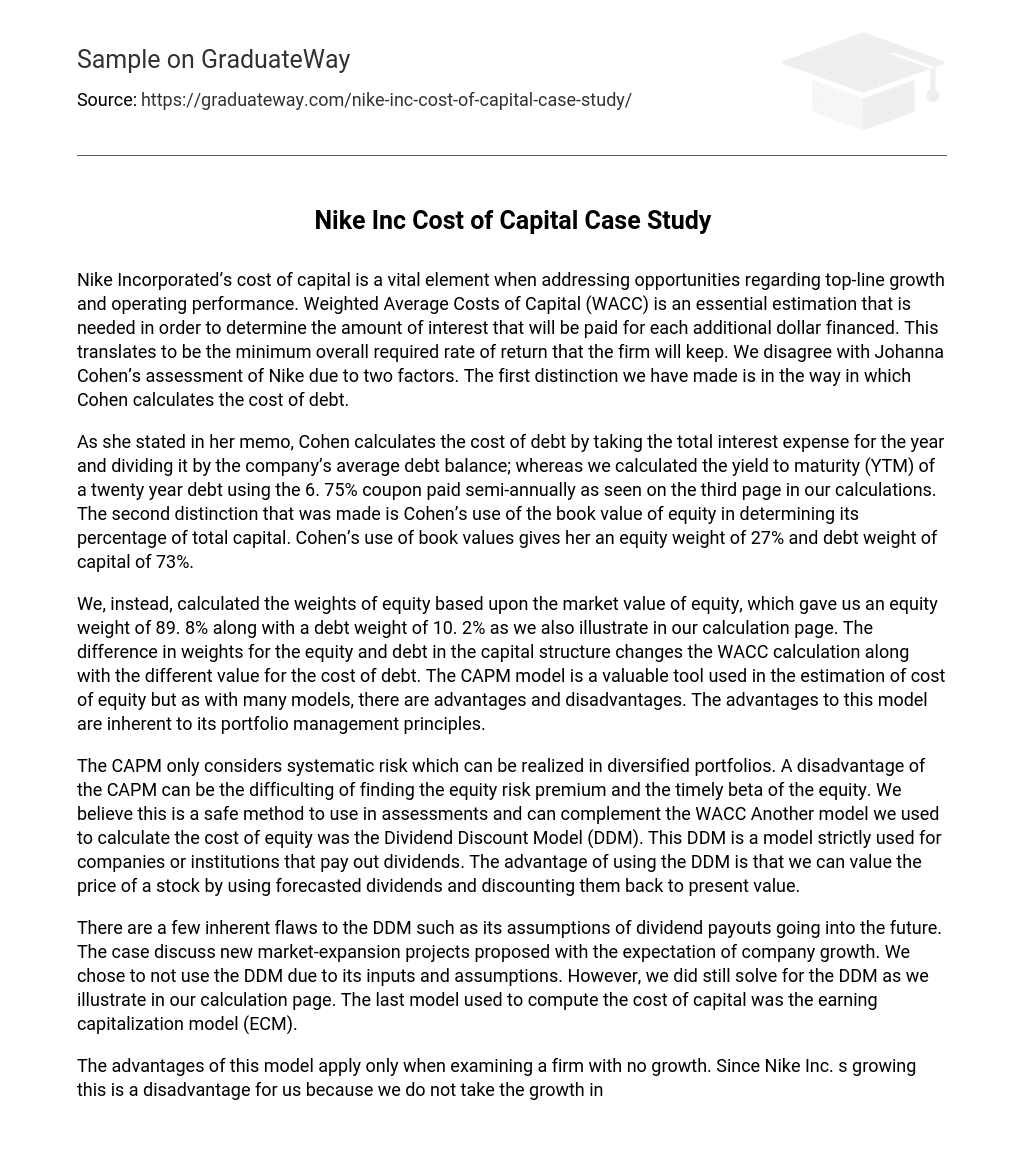Nike Incorporated’s cost of capital is crucial for assessing opportunities for top-line growth and operating performance. The Weighted Average Cost of Capital (WACC) is a necessary estimate to determine the interest paid for each additional dollar financed. In other words, it represents the minimum required rate of return for the firm. We have two disagreements with Johanna Cohen’s evaluation of Nike. Firstly, we differ in how Cohen calculates the cost of debt.
According to her memo, Cohen calculates the cost of debt by dividing the total interest expense for the year by the company’s average debt balance. In contrast, our calculations on the third page show that we calculated the yield to maturity (YTM) of a twenty year debt using the 6.75% coupon paid semi-annually. Another difference is Cohen’s use of the book value of equity to determine its percentage of total capital. By using book values, Cohen assigns an equity weight of 27% and a debt weight of capital of 73%.
Instead of relying on other factors, we used the market value of equity to determine the weights of equity. This method resulted in an equity weight of 89.8% and a debt weight of 10.2%, which can be found on our calculation page. These differences in weights have implications for both the computation of the Weighted Average Cost of Capital (WACC) and the cost of debt. The Capital Asset Pricing Model (CAPM) is a useful tool for estimating the cost of equity, but it also has its own advantages and disadvantages, just like any model. One advantage is that it aligns with portfolio management principles.
The text addresses the drawbacks and advantages of two models, namely the Capital Asset Pricing Model (CAPM) and the Dividend Discount Model (DDM), that are employed to determine the cost of equity. The CAPM solely considers systematic risk in diversified portfolios. One downside is the difficulty in obtaining accurate data on equity risk premium and timely beta of the equity. Nevertheless, we consider it a reliable approach for evaluations, which can complement the Weighted Average Cost of Capital (WACC). Conversely, the DDM is specifically applicable for entities that distribute dividends. Its strength lies in its ability to assess stock value by projecting dividends and discounting them to present value.
Despite its assumptions of future dividend payouts, the DDM has some inherent flaws. The case discusses new market-expansion projects that are expected to lead to company growth. We decided not to utilize the DDM because of its inputs and assumptions. Nevertheless, we did calculate using the DDM, as demonstrated in our calculation page. The ECM, or earning capitalization model, was the final model employed for determining the cost of capital.
The benefits of this model only apply when considering a firm without growth. However, since Nike Inc. is experiencing growth, this becomes a disadvantage for us as we don’t take the growth into account. Hence, we reject both this model and the Dividend Discount Model (DDM). According to our calculations, the Expected Cash Flow Method (ECM) gives a result of 5.13%. To reassess the Weighted Average Cost of Capital (WACC) for Nike, we will use a calculation that involves the weights of debt and equity, the cost of debt, the tax rate on the debt, the weight of equity, and the cost of equity. We used three different formulas to reach our conclusion. First, we calculated the Capital Asset Pricing Model (CAPM), which resulted in a solution of 10.5%.
Next, we determined the Cost of Debt to be 7.16%. When calculating the WACC, the prescribed percentage was 11.17%, but our solution was 9.88%. Any estimate lower than the discount rate indicated that the stock is undervalued. Since our calculated discount rate based on the WACC is lower, this further supports the fact that the stock is undervalued. Consequently, we conclude that Nike is a recommended stock and a sound investment. Therefore, our calculations for the cost of debt and the capital structure differ from Cohen’s analysis, which provided her with a discount rate of 8.4%.
Cohen’s discount rate would put the current price as undervalued, but our analysis predicts it to be even more undervalued. It is also important to consider a conservative outlook when using models.





